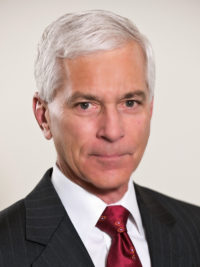![]()
The data from NACUBO’s most recent tuition discounting study “show that American higher education is moving into dangerous and uncharted waters that demand different decisions based on new ways of thinking.” So writes Brian Mitchell, former president of Bucknell University and Washington & Jefferson College, in a recent Huffington Post blog entry.

president and CEO of NACUBO
Mitchell, now a higher education consultant, goes on to say: “The problem is that America changed fairly dramatically in the early years of the 21st century, evolving into a weary and less optimistic society tested by incessant war, manufacturing decline, new technology, and global competition … . Colleges and universities largely looked inward, relying on older assumptions that tuition fees, government loans, student debt, institution retrenchment—and for the lucky few, endowment drawdowns—made possible.”
This year’s tuition discount study debunks one of those assumptions: that raising the discount rate will continue to drive enrollment. In fact, the average rate reached an all-time high of 48.6 percent for full-time freshmen, up from 47.1 percent the year before.
At the same time, the NACUBO study shows that 37.5 percent of institutions reported declines in freshman classes and across the entire undergraduate bodies from 2014–15. Among undergraduates, 77.2 percent received institutional grants for that academic year.
These numbers—along with the ongoing funding challenges for public institutions—underscore the need for critical tools and initiatives that NACUBO has set as priorities: the Economic Models Project (EMP) and the “Value of Higher Education” article series.
This issue of the magazine explains some significant findings of the EMP committee, which conducted dozens of focus groups with representatives of not only the association’s four constituent groups, but also with leaders from other higher education associations, think tanks, and state budget offices.
Thousands of comments collected from the groups point out many similarities in the suite of challenges facing higher education leaders. At the same time, unique barriers emerged for each constituency.
The sections of this issue are built around higher education’s historical roots, current pressures, and projections for the future
Defining Forces
“How Did We Get Here?” is based in large part on the first of three white papers—outcomes of the Economic Models Project—written by EMP leaders Bob Shea and Jacalyn Askin. “What Is the Current State of Economic Sustainability of Higher Education in the United States—and How Did We Get Here?” highlights the first 400 years of America’s higher education history. From Harvard University’s founding in 1636, to the Morrill Act, to the GI Bill—and on to the first Higher Education Act, in 1965—colleges and universities have evolved from institutions for the elite to a benefit accessible by the masses. Along the way, the higher education business model was redefined in response to expansion and the complex processes of funding a growing number of students. Pell Grants, student loans, and federal and state support boosted resources available to potential college students. In recent years, large declines in state funding, an arms race to provide the most upscale facilities, and other factors have fueled tuition increases, which the public considers high enough to bring into question the value of higher education itself.
Don’t miss Associate Editor Khesia Taylor’s “Timeline Tutorial” for a pictorial review of higher education’s evolution.
Rough Times, Creative Solutions
In “Present, Tense,” you’ll find a series of case studies and interviews, describing initiatives that are bringing new revenue, efficient processes, and increased student success to many institutions. Organized by constituent group, these stories describe, for example, the University of New England’s composite financial index turnaround (from 1.4 to 5.0), accomplished in part by filling identified niches for online programs; and, in “The Next Big Thing,” by Cathy Wood, Florida Institute of Technology’s laser focus on providing students real-world technology experiences that keep young people engaged, graduating, and ready for future success.
In “Automating Applications,” David Martinez explains St. John’s University’s process improvements to streamline assistantship and fellowship awards, better serving students and freeing up staff time. And, a series of articles about community colleges highlights the difficult decisions undertaken to regain control over financial reserves; a major statewide workforce preparation effort; and an early-alert system triggering advising support for students who are veering off track.
Future Values
What does the future hold for higher education? It’s complicated. The NACUBO 2016 Profile of Higher Education Chief Business Officers reveals that retirement in the next five years is on the minds of more than 40 percent of the CBOs responding to the survey, pointing to a lot of leadership churn. In “Who’s Up Next?” Apryl Motley digs deeper into the study to uncover the succession plans—and lack thereof—at several colleges and universities.
In recent years, the long-held notion that higher education is a public good, benefiting all aspects of the economy and society, has come under serious question. In response, we’re developing key messaging for stakeholders to turn to when communicating the other side of the value story. “The Value of a Lifetime,” in our June issue, kicked off a series of articles supporting this tangible—and sometimes nuanced—value of higher education to individuals and society. In Karla Hignite’s “Individual Impact” feature, you’ll read the stories of alumni who have become everything from law clerk, to construction company CEO; from NIH research fellow, to application developer at Intel—all with amazing twists and turns along the way.
Finally, in “The Next Chapter,” Deputy Editor Preeti Vasishtha invited three higher education leaders—one, an official futurist—to speculate on the future of colleges and universities. Waded Cruzado, president, Montana State University, discusses practical strategies to strengthen the university’s own economic foundation, while Bryan N. Alexander, futurist, researcher, and consultant, presents four future scenarios unfolding by 2025. Each situation presents challenges and opportunities for business officers.
Circling back to Brian Mitchell, he writes, in “Institutional Introspection”: “What’s striking about higher education modeling is that there’s so little to work with at the margins. … But it has enough flexibility built in to put the pieces of the puzzle together differently. … As for-profit institutions measure their costs increasingly against retention, graduation, employment, and future income levels, the same criteria will also be applied to the nonprofits.”
What’s the future of higher education? It’s complicated, but we will all play an important part in drafting the next chapter.
JOHN WALDA is president and CEO of NACUBO.



